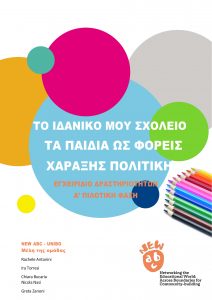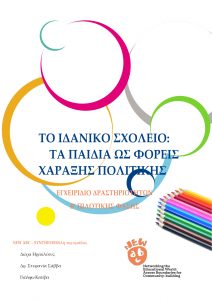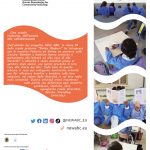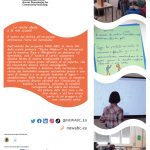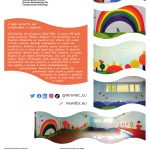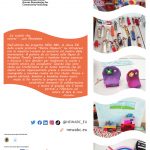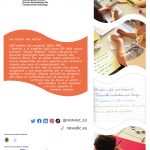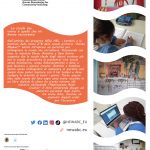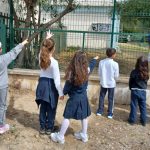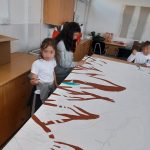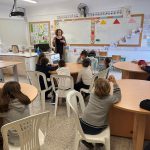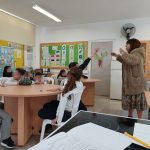Το NEW ABC θέλει να μοιραστεί μερικές συμβουλές για να σας διευκολύνει να προσαρμόσετε τις δραστηριότητες στο δικό σας πλαίσιο. Κάντε κλικ σε καθεμία από αυτές για να δείτε μια εκτενέστερη επεξήγηση με παραδείγματα και περισσότερες λεπτομέρειες.
Αξιολογήστε τον καταλληλότερο τρόπο προσέγγισης της γλωσσικής και πολιτισμικής ποικιλομορφίας
Προσαρμόστε ελεύθερα τις δραστηριότητες που περιλαμβάνονται σε αυτή τη δράση ανάλογα με το πλαίσιο και τους συμμετέχοντες. Για παράδειγμα, η εστίαση μπορεί να μην είναι η ίδια εάν εργάζεστε για τη γλωσσική και πολιτιστική ποικιλομορφία με τοπικές ή μακροχρόνια εγκατεστημένες κοινότητες μεταναστών, ή εάν οι συμμετέχοντες είναι πρόσφατα αφιχθέντες πρόσφυγες, οι οποίοι μπορεί να χρειάζονται μια διαφορετική προσέγγιση για να ανακαλύψουν τη γλωσσική και πολιτιστική κληρονομιά της κοινότητας υποδοχής.
Σχεδιάστε με ευελιξία και αποφύγετε την απογοήτευση αν οι δραστηριότητες δεν πάνε όπως αναμενόταν
Αντίθετα, αφήστε τους μαθητές να καθοδηγήσουν και τελικά να μετατρέψουν τις δραστηριότητες ανάλογα με τις ανάγκες και τα ενδιαφέροντά τους. Για παράδειγμα, τα παιδιά μπορεί να ενδιαφέρονται να χρησιμοποιήσουν τις προτεινόμενες δραστηριότητες για να συζητήσουν άλλες σχετικές εμπειρίες και προβληματισμούς ή να χρησιμοποιήσουν άλλους τρόπους για να εκφράσουν τις απόψεις τους. Έτσι, όταν σχεδιάζετε τις δραστηριότητές σας, προσπαθήστε να παρέχετε διαφορετικές επιλογές και χώρους για τη λήψη αποφάσεων από τους μαθητές και μην αγχώνεστε μπροστά σε απροσδόκητες αλλαγές, καθώς αυτό αποτελεί μέρος της συνδημιουργίας.
Μην προκαθορίζετε τις γλώσσες, τους πολιτισμούς και άλλες βασικές έννοιες.
Ακολουθώντας τις αρχές της συνδημιουργίας και της συνεργασίας, αποφύγετε την επιβολή προκαθορισμένων ορισμών των βασικών εννοιών της δράσης και επιτρέψτε στα παιδιά να εκφράσουν και να οικοδομήσουν τις δικές τους αντιλήψεις για τις γλώσσες και τους πολιτισμούς σύμφωνα με το ρεπερτόριο και τις εμπειρίες της ζωής τους. Διατηρήστε ανοιχτό μυαλό και σκεφτείτε ότι ξεκινώντας από ό,τι είναι σχετικό για τα ίδια, η δράση σας πιθανόν να αποκτήσει περισσότερο νόημα και να γίνει πιο ελκυστική.
Εξερευνήστε τη γειτονιά όπου θα αναπτυχθεί η δράση σας πριν βγείτε με τους μαθητές
Αυτό θα σας επιτρέψει να εντοπίσετε πιθανές ευκαιρίες και προκλήσεις για την εξερεύνηση των παιδιών κατά τη διάρκεια της δραστηριότητας της εκδρομής, ώστε να μπορέσετε να προωθήσετε και να υποστηρίξετε καλύτερα τον προβληματισμό τους σχετικά με το πολιτιστικό και γλωσσικό τοπίο γύρω τους. Το να έχετε μια προηγούμενη ιδέα για το τι μπορεί να βρεθεί στο τοπικό τους πλαίσιο μπορεί επίσης να είναι χρήσιμο για να αποφασίσετε πόσες ομάδες θα δημιουργήσετε για την εκδρομή και πόσοι ενήλικες θα χρειαστούν για να τις προσέχουν, καθώς και πόσες τοποθεσίες θα καταγράψετε ανά ομάδα και ποιες περιοχές θα ήταν πιο βολικές για εξερεύνηση.
Προσδιορίστε κάποια ελκυστική πηγή ή πηγές που θα μπορούσαν να λειτουργήσουν ως έναυσμα για να ξεκινήσετε τη δράση σας.
Αυτό θα μπορούσε να είναι, για παράδειγμα, ένα μουσικό βίντεο, μια ταινία κινουμένων σχεδίων μικρού μήκους ή οποιοσδήποτε άλλος πόρος από την παιδική/νεανική λαϊκή κουλτούρα που θα μπορούσε να χρησιμεύσει για να εισαγάγει το θέμα της γλωσσικής και πολιτισμικής ποικιλομορφίας με ελκυστικό τρόπο και να ενθαρρύνει τους μαθητές να μιλήσουν για τις σχετικές εμπειρίες τους. Η χρήση ενός ελκυστικού «αγκίστρου» στην πρώτη σας συνάντηση μπορεί να κάνει μεγάλη διαφορά στη διάθεση των παιδιών για βαθύτερο προβληματισμό στις επόμενες δραστηριότητες. Μπορείτε επίσης να χρησιμοποιήσετε αυτόν τον πόρο για να ανοίξετε την αίθουσα για τις προτιμήσεις των μαθητών.
Να εκφράζουν και να αναγνωρίζουν τις πολλαπλές εμπειρίες, τις γλώσσες, τους πολιτισμούς, τους τρόπους και τους τρόπους συμπεριφοράς των μαθητών.
Πολλά από τα πράγματα που γνωρίζουν και κάνουν τα παιδιά στην καθημερινή τους ζωή δεν είναι συνήθως ορατά ή δεν αναγνωρίζονται στο σχολείο, συμπεριλαμβανομένων των γλωσσών που γνωρίζουν και χρησιμοποιούν στο σπίτι, καθώς και άλλων χαρακτηριστικών και δεξιοτήτων. Αναζητήστε ευκαιρίες για να αφήσετε αυτές τις πρακτικές να αναδυθούν και να επαινεθούν στο πλαίσιο αυτής της δράσης, ώστε τα παιδιά να γνωρίζουν ότι όλο το γλωσσικό και πολιτισμικό τους ρεπερτόριο εκτιμάται. Για παράδειγμα, μπορείτε να ενθαρρύνετε τους μαθητές να χρησιμοποιούν τις γλώσσες του σπιτιού τους στις δραστηριότητες και να διδάσκουν κάποιες βασικές έννοιες στους συμμαθητές τους και στους ενήλικες διαμεσολαβητές, ή να φέρνουν και να συμπεριλαμβάνουν τις πολιτισμικές τους γνώσεις στις δραστηριότητες.
Επιτρέψτε στα παιδιά να χρησιμοποιούν πολλαπλές μορφές συμμετοχής
Είναι γνωστό ότι οι ενσώματες και καλλιτεχνικές προσεγγίσεις επιτρέπουν στους μαθητές να εκφράζουν συναισθήματα και ιδέες που δεν αναδύονται πάντα μέσω άλλων οδών. Χρησιμοποιήστε τη φαντασία σας κατά το σχεδιασμό των δραστηριοτήτων και ενθαρρύνετε τη συμμετοχή των μαθητών μέσω πολλαπλών και δημιουργικών μορφών που υπερβαίνουν την τυπική σχολική δυναμική, η οποία συνήθως βασίζεται στην προφορική ή γραπτή έκφραση. Για παράδειγμα, μπορείτε να συμπεριλάβετε χώρους για ζωγραφική ως εναλλακτική λύση στη γραφή για τα παιδιά που δεν μιλούν ακόμη άπταιστα τη γλώσσα του σχολείου ή να ενθαρρύνετε τη χρήση παιχνιδιών ρόλων, παιχνιδιών, τραγουδιού, χορού και άλλων τρόπων έκφρασης που μπορεί να διευρύνουν τις πιθανότητες συμμετοχής όλων.
Δώστε χώρο σε τοπικούς καλλιτέχνες για να μπορέσουν τα παιδιά να έρθουν σε επαφή με ποικίλες μορφές έκφρασης
Ένας ελκυστικός τρόπος για να ανοίξετε χώρους για τη δημιουργικότητα και τη συμμετοχή των μαθητών σε αυτή τη δράση είναι να προσκαλέσετε έναν ή περισσότερους τοπικούς καλλιτέχνες να μοιραστούν τη δουλειά τους και να συμμετάσχουν οι μαθητές σε μια συλλογική καλλιτεχνική παράσταση. Αυτή η ανταλλαγή θα μπορούσε να βοηθήσει τους μαθητές να γνωρίσουν τις διάφορες μορφές καλλιτεχνικής δημιουργίας που μπορεί να είναι διαθέσιμες γι’ αυτούς για να εκτελέσουν και τις δυνατότητές τους για αυτοέκφραση.
Γίνε πρότυπο και γίνε μέρος του προβληματισμού
Χρησιμοποιήστε αυτή τη δράση για να προβληματιστείτε σχετικά με τις δικές σας γλωσσικές και πολιτισμικές εμπειρίες και να μοιραστείτε την ιστορία σας με τους μαθητές. Για παράδειγμα, δημιουργήστε τη δική σας αυτοβιογραφική αφήγηση και μοιραστείτε την με τους μαθητές, εξηγώντας την πορεία της ζωής σας σε σχέση με τις γλώσσες, τις ποικιλίες και τους πολιτισμούς. Παράλληλα με το να αποτελέσετε πρότυπο για τους προβληματισμούς τους, ίσως εκπλαγείτε από τα δικά σας ευρήματα!
καθοδηγήστε προσεκτικά τις δραστηριότητες, ώστε να μπορούν να συζητηθούν και να αναθεωρηθούν κριτικά τα λογικά ζητήματα που μπορεί να προκύψουν.
Μην εκπλαγείτε αν ο επιδιωκόμενος προβληματισμός γύρω από τη γλωσσική και πολιτισμική ποικιλομορφία οδηγήσει τα παιδιά να εκφράσουν τις απόψεις ή τις ανησυχίες τους γύρω από άλλα ευαίσθητα θέματα, όπως ο ρατσισμός και άλλες μορφές διακρίσεων. Ενδέχεται επίσης να εκφράσουν κατά τη διάρκεια των δραστηριοτήτων τις δικές τους γλωσσικές και πολιτισμικές προκαταλήψεις και στερεότυπα σχετικά με ορισμένες γλώσσες, προφορές ή κοινότητες. Αντί να αποφεύγετε αυτά τα θέματα, προσπαθήστε να είστε προετοιμασμένοι και να τα χρησιμοποιείτε για κριτικό προβληματισμό.
Να είστε έτοιμοι να ανακατευθύνετε τη συζήτηση των μαθητών πίσω στα κύρια σημεία
Μέχρι στιγμής, έχουμε συστήσει να είμαστε ευέλικτοι και να αφήνουμε τα ενδιαφέροντα των μαθητών να καθοδηγούν τη δράση. Ωστόσο, μπορεί να υπάρξουν στιγμές που η πρωτοβουλία τους θα τους οδηγήσει μακριά από τα κύρια θέματα και τους στόχους της πρότασης, σε κατευθύνσεις όπου μπορεί να χάσουν την ευκαιρία να προβληματιστούν σχετικά με τη γλωσσική και πολιτισμική ποικιλομορφία γύρω τους. Αν συμβαίνει αυτό, μπορείτε να έχετε προετοιμάσει κάποιες στρατηγικές για να τους επαναφέρετε στο θέμα, για παράδειγμα, μοιραζόμενοι μια προσωπική εμπειρία και ζητώντας τη γνώμη τους ή προβάλλοντας κάποιο ελκυστικό οπτικοακουστικό υλικό που μπορεί να προωθήσει την ομαδική συζήτηση.
Εμπλέκονται όσο το δυνατόν περισσότερο οι οικογένειες και άλλα μέλη του σχολείου ή της κοινότητας.
Όταν σχεδιάζετε τις δραστηριότητές σας, σκεφτείτε πιθανούς τρόπους για να εμπλέξετε τις οικογένειες των μαθητών και την ευρύτερη κοινότητα τόσο στις διαδικασίες της δράσης όσο και στα τελικά αποτελέσματα. Αυτό μπορεί να γίνει ζητώντας από τους μαθητές να εξηγήσουν ή να υλοποιήσουν κάποιες από τις δραστηριότητες στο σπίτι (για παράδειγμα, θα μπορούσαν να δημιουργήσουν τη γλωσσική βιογραφία ενός μέλους της οικογένειας) και να φέρουν κάποια ανατροφοδότηση στις συνεδρίες. Και, φυσικά, η συμμετοχή της οικογένειας μπορεί να προωθηθεί με τη διοργάνωση κάποιου είδους τελικής παρουσίασης για τους γονείς, τα αδέλφια, τους φίλους και την υπόλοιπη σχολική και εξωσχολική κοινότητα, όπως κάναμε στη δράση μας.
Εξοικονομήστε λίγο χρόνο μετά από κάθε δραστηριότητα και στο τέλος του έργου για συλλογικό προβληματισμό.
Αυτό θα μπορούσε να αποτελέσει σημαντικό χώρο για τη σύνδεση της εργασίας που γίνεται και των εμπειριών που βιώνονται κατά τη διάρκεια κάθε συνεδρίας με τους κύριους στόχους της δράσης. Όπως και στις προηγούμενες συμβουλές, μπορείτε επίσης να είστε δημιουργικοί εδώ και να προτείνετε ποικίλες και δυναμικές μορφές κριτικού αναστοχασμού, έτσι ώστε όλοι να βρουν έναν τρόπο να συμμετάσχουν. Αν δεν υπάρχει πολύς χρόνος σε κάθε συνεδρία για έναν σωστό συλλογικό αναστοχασμό, μπορείτε να χρησιμοποιήσετε κάποιο είδος «πάσο εξόδου», ζητώντας από τους μαθητές να μοιραστούν μια λέξη ή ένα σύντομο σχόλιο για εκείνη την ημέρα πριν φύγουν από την αίθουσα.
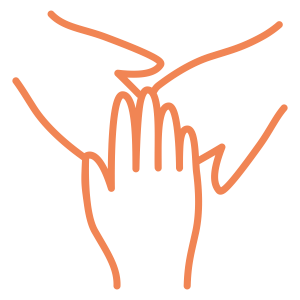 Τύπος δράσης
Τύπος δράσης